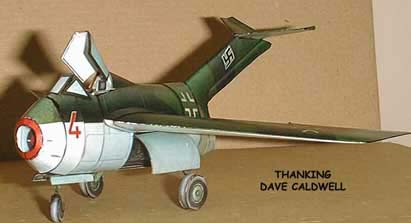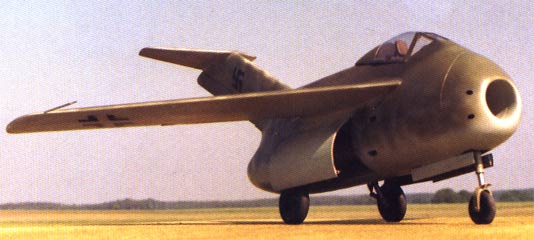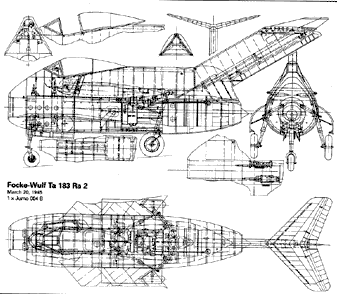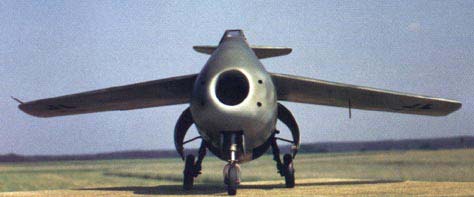
Huckebein - $$5.95
Some sources say that the famous Soviet MiG-15 was at least inspired by the Ta 183 because the Soviets captured plans and prototypes for the Ta 183 from the Germans at the end of World War II. The MiG-15 shared the general layout of high tailplane, bubble canopy, and nose mounted intake and guns.
The Nazi WWII Secret X-Plane-Huckebein Ta-183
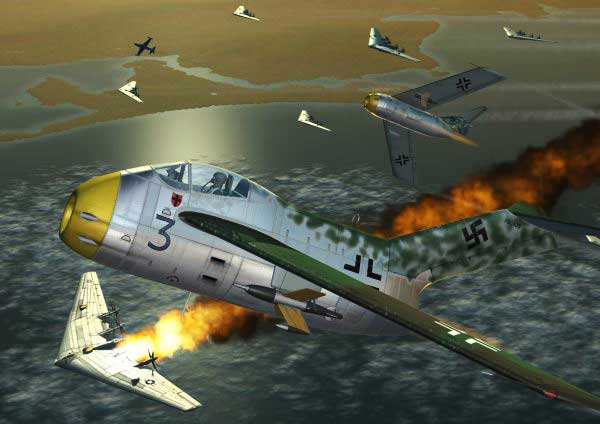
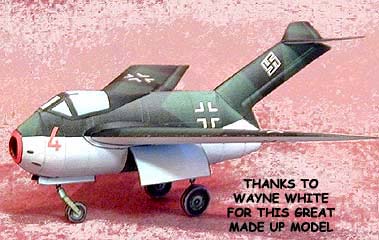 The Nazi WWII Secret X-Plane Focke Wulf Ta-183 Huckebein was the officially recognized identifier however, soon thereafter it became known by the nickname Huckebein, after a cartoon raven who got others into trouble.
The Nazi WWII Secret X-Plane Focke Wulf Ta-183 Huckebein was the officially recognized identifier however, soon thereafter it became known by the nickname Huckebein, after a cartoon raven who got others into trouble.
This was one of the last secret Nazi X-planes that were designed by the brilliant German designers and almost flown at the very end of WWII.. A scarcity of parts and constant bombing of the factories made things difficult as best.
The Allied forces crated and sent home the prototypes for 'evaluation'. Both the Russians and the Americans came out with a flying version in the late 1940s.
My name is Jens Heydel ,I recently purchased online a few of your fine models .All I can say is "WOW" !!!! I included a shot of my FW 183 model .I have never attempted to build anything like this before having been a free flight "stick and tissue " modeler .I was amazed at how well the model went together .Add me to the satisfied customer list .I will be buying the entire collection which I guess is on the CD? .Anyway thanks very much for bringing to market such an excellent product. Sincerely Jens Heydel (2/03)
FW Ta-183 swept wing Huckebein Nazi X-plane
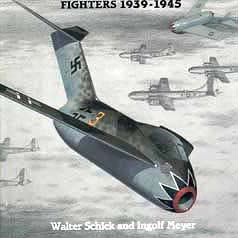 In January 1944, Entwurf 5, design description Nr. 279, was
advanced by Focke-Wulf engineers, This fifth design draft contained
plans for two versions of a new fighter. The first, Plan V (P
V), was to be powered by a HeS 01 1A and be equipped for high
altitude operations at 46,000 ft (14,000 m). Plans for this aircraft
were approved by the RLM which sanctioned further development
under the GL/C designation Fw 2522. At the same time it also became
the new official Entwurf 3, replacing the former Draft 3 concept
study, which had already been abandoned.
In January 1944, Entwurf 5, design description Nr. 279, was
advanced by Focke-Wulf engineers, This fifth design draft contained
plans for two versions of a new fighter. The first, Plan V (P
V), was to be powered by a HeS 01 1A and be equipped for high
altitude operations at 46,000 ft (14,000 m). Plans for this aircraft
were approved by the RLM which sanctioned further development
under the GL/C designation Fw 2522. At the same time it also became
the new official Entwurf 3, replacing the former Draft 3 concept
study, which had already been abandoned.
The second variant was a short stubby fighter design with swept wings and powered by a turbojet and rocket motor. The HeS 01 1A was augmented by a bi-fuel rocket motor to be mounted above and slightly aft of the turbojet. Known as Plan VI (P VI), the new design study appealed to the RLM which sanctioned continued development of this interceptor fighter.
This design study then became the official new Entwurf 2 (with the cancellation of the 1943 Plan 11 concept study). Initially Focke-Wulf applied the RLM GL/C designation Fw 232 to the new fighter,but since this number had already been assigned to Arado for their Ar 232 transport which, was in active service with the Luftwaffe (although in very modest numbers), the Air Ministry reassigned the unused GL/C number 183 to the design, concurrently allowing Kurt Tank to add the first two letters of his surname as a prefix.
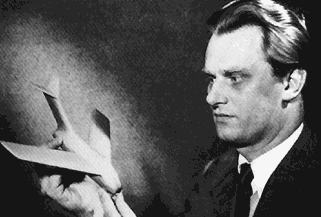 Hans Multhopp holds a scale model of his Ta 183. Multhopp who, as a young gifted aerodynamicist at Focke-Wulf, was a member of Kurt Tank's advanced design team responsible for the Ta 183. After the war, Multhopp accepted a job with the Glenn L. Martin Company in Baltimore, Maryland. Multhopp was Tank's theoretical advisor who recognized and understood the advantages of the swept wing. |
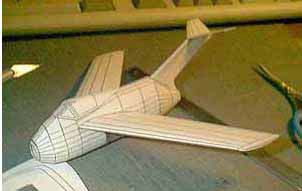 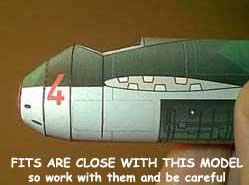 As every new model is evolving , many images are passed around the designers for comments.. These a just a couple samples . |
The Ta 183 was the officially recognized
identifier however, soon thereafter it became known by the nickname
Huckebein, after a cartoon raven who got others into trouble.
 Created under the direction of Dipl.-Ing. Hans Multhopp,
the new Focke-Wulf fighter design had been expanded to include
four possible variations of the theme. The first of these, the
Ta 183 Ra- 13, was equipped with the HeS 0 11 R which was a turbojet
fitted with an auxiliary bi-fuel rocket motor. The Ta 183 Ra-2
was similar but switched to the Jumo 004B and had an increased
wingspan. The Ta 183 Ra-3 was to revert to the HeS 011 but without
the rocket motor.
Created under the direction of Dipl.-Ing. Hans Multhopp,
the new Focke-Wulf fighter design had been expanded to include
four possible variations of the theme. The first of these, the
Ta 183 Ra- 13, was equipped with the HeS 0 11 R which was a turbojet
fitted with an auxiliary bi-fuel rocket motor. The Ta 183 Ra-2
was similar but switched to the Jumo 004B and had an increased
wingspan. The Ta 183 Ra-3 was to revert to the HeS 011 but without
the rocket motor.
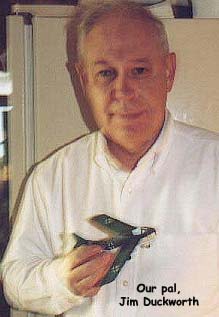 Beta Buddy Jim Duckworth sends in this photo saying: "It's a cute little rascal and it was fun to build." |
We sure would love to see a few models of the most popular jet turbines.. Any one up to it?? The Sabre Jet (F-86) is screaming for one.. chip 02/29/02 |
Throughout 1944, Dipl.-Ing. Multhopp and his Associates, accomplished much with the Ta 183, but continued production difficulties with the complex HeS 011 retarded development. In spite of the fact that the Jumo 004 was already considered for the Ta 183, this new engine was essentially earmarked for the Me 262 that was then entering production. Nevertheless, on January 10, 1945, a small number of Jumo 004s were made available to Focke-Wulf for the Ta 183 program as set forth in short description Nr. 30. Although a number of production schedules had to be constantly amended, the final schedule called for the first three flying prototypes (Ta 183 V1 - V3) to be patterned after the Ta 183 Ra-2 to Ra-4 with the V1 receiving the Jumo 004B and the others fitted with the long-awaited HeS 011 A-0. In the event the HeS 011 was not available in time, all three prototypes were to use the Jumo 004B as a stopgap until production of the HeS 011 A-1 could begin during the summer of 1945.
|
|
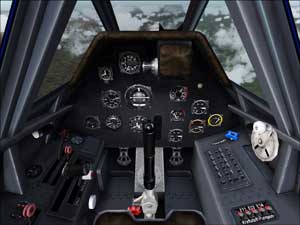 |
Cockpit of the Focke Wulf Ta-183 Huckebein. |
Specifications
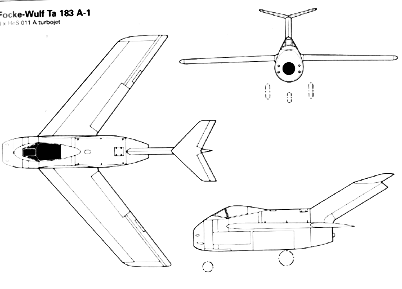 |
Length: 30 ft 2 in Wingspan: 32 ft 10 in Wing area: 242 ft² Empty weight: 5,247 lb Loaded weight: 9,480 lb Powerplant: 1× Heinkel HeS 011 turbojet, 3,507 lbf Performance Felix du Temple Maximum speed: 593 mph Service ceiling: 45,932 ft Rate of climb: 4,020 ft/min Wing loading: 41 lb/ft² Thrust/weight: 0.37 Armament 4 × 30 mm (1.18 in) MK 108 cannons 4 × Ruhrstahl X-4 Wire Guided AAMs or 1,102 lb of bombs |



